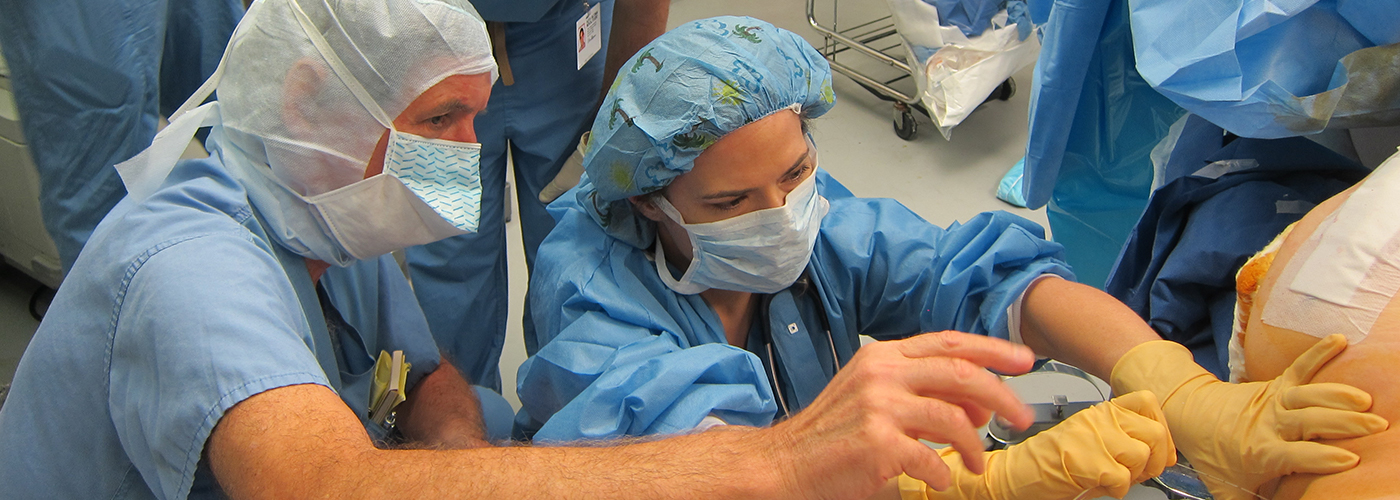Perioperative Pain Service (POPS)
The Perioperative Pain Service (POPS) is committed to reducing postoperative pain and assisting with the early phases of rehabilitation from orthopedic surgery. POPS provides safe and effective pain management for all surgical patients.
POPS consists of a specialized team of clinicians with expertise in perioperative pain control, including physicians, nurse practitioners, physician assistants, and social workers.
POPS provides state-of-the-art postoperative pain control and continuously manages and assesses both pain-relief medications and the techniques used to administer them. After surgery, members of the POPS team visit each patient once or twice daily depending on the efficacy of their current postoperative pain regimen. If questions, concerns, or problems arise, a clinical team member is available 24 hours a day, seven days a week.
Comprehensive Pain Management
POPS uses a multimodal approach to postoperative pain control. This means that several different types of pain medications are used to help reduce pain in different ways. This approach to pain management helps limit the side effects of high doses of one pain reliever while reaping the benefits of pain relief from a different, complementary technique. In particular, every effort is made to limit exposure and need for postoperative opioids.
Many of our patients will be able to use a method of pain relief called patient-controlled analgesia (PCA). This method allows patients to customize the delivery of their pain medication via intravenous, epidural, or continuous nerve block routes. Patients can give themselves additional small doses of pain medication on an as-needed basis. This flexibility allows POPS to address patients' individualized needs and optimize the pain regimen that works best for each patient.
POPS establishes limits within the patient-controlled analgesia delivery system to help reduce side effects from certain pain medications. However, patients are still able to give themselves additional doses of medicine to control pain during peaks of discomfort (during physical therapy, for example). This approach to pain management has been associated with higher levels of patient satisfaction, better pain control, and fewer side effects. It should be noted that pain management varies for each patient, and patients may still experience side effects including nausea, itching, sleepiness, and numbness. The POPS team will continue to monitor you for these side effects and adjust your pain regimen accordingly to ensure that the most effective approach is being taken for your postoperative comfort.
Patients are transitioned to oral pain medications, usually beginning on the first or second day after surgery, in anticipation of discharge from the hospital. The POPS team will work with you diligently to ensure that, when you are medically cleared for discharge, you are sent home on pain medication that is effective and well-tolerated.
Opioid-Sparing Approaches to Postoperative Pain
In certain circumstances, the POPS team may recommend a postoperative approach to pain control that either limits or eliminates the use of narcotic pain medications. Prescription narcotic pain medications, most commonly known as opioids, sometimes cause side effects including nausea and vomiting, and carry a small risk of producing physical dependence and/or addiction.
As a result, when appropriate, the POPS team is committed to encouraging alternative measures of pain control that minimize the possibility of these risks and side effects. While there is a clinical indication for opioids in many orthopedic cases (during the immediate postoperative period), it is not the only pain control method POPS uses to manage postoperative pain. In most cases, the POPS team will work with you and your medical team on a daily basis to continue decreasing the dose and frequency of opioid pain medication during your recovery.
Peripheral nerve blocks, epidural analgesia, infiltration of local anesthetics to the surgical site, and ice therapy are just a few non-opioid approaches to pain control after orthopedic surgery. Other opioid-sparing approaches to pain management include anti-inflammatory drugs, anti-seizure/neuropathic medications, and muscle relaxers that are used in tandem with other methods to help reduce pain after surgery. The use of alternative therapies such as meditation-based visualization, mindfulness, and deep breathing exercises may also be offered as part of your treatment as well.
Preoperative Optimization for Complex Pain Patients
Some surgical patients may be asked to get a preoperative pain screening, which helps the healthcare team understand a patient's presurgical pain levels so they can optimize the postsurgical pain management plan. At HSS, this screening is conducted by the Complex Pain Team. If you have had prior difficulties with pain management, please inform your surgery team, as a preoperative screening by the Complex Pain Team may be optimal.
Alternatively, if you have a history as outlined below, then you should be seen by the Complex Pain Team in the weeks leading up to surgery:
- Taking opioids for the past 3 months
- Taking buprenorphine, Subutex, Suboxone, or methadone
- History of substance use disorder or alcohol/drug dependency
- Have an implanted intrathecal pump or spinal cord stimulator
Short-Term Postoperative Consultation
Some of our patients may continue to have trouble controlling their pain following surgery. A POPS practitioner is available to assist your surgical team in modifying your pain management plan and, if necessary, to help develop a strategy for tapering off your opioid pain medications. Our duration of involvement is limited to 90 days after surgery, as this corresponds to scientific definitions for duration of postoperative pain.
Read our Opioid Prescription Policy
Back to Department of Anesthesiology, Critical Care & Pain Management
